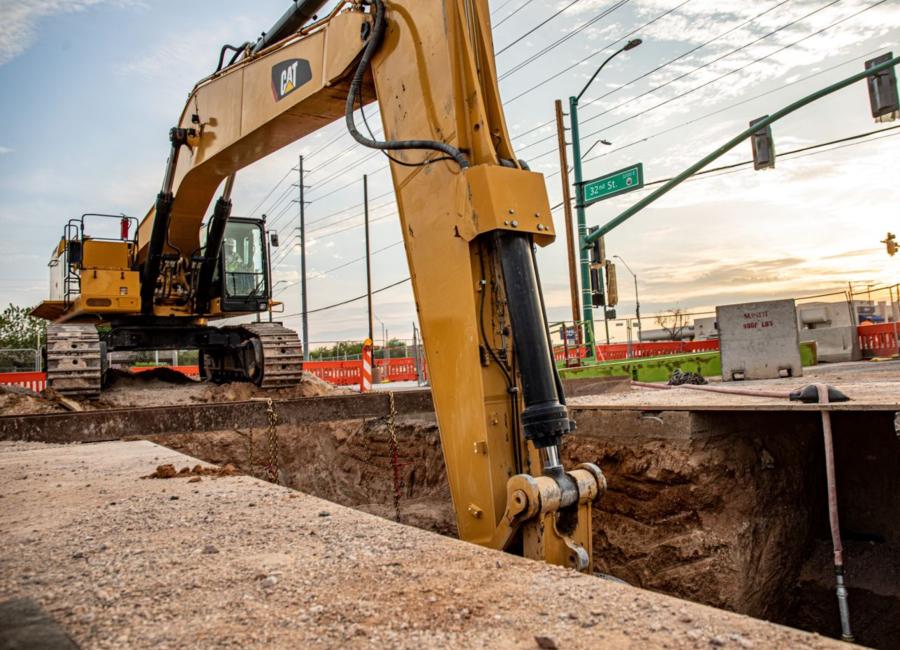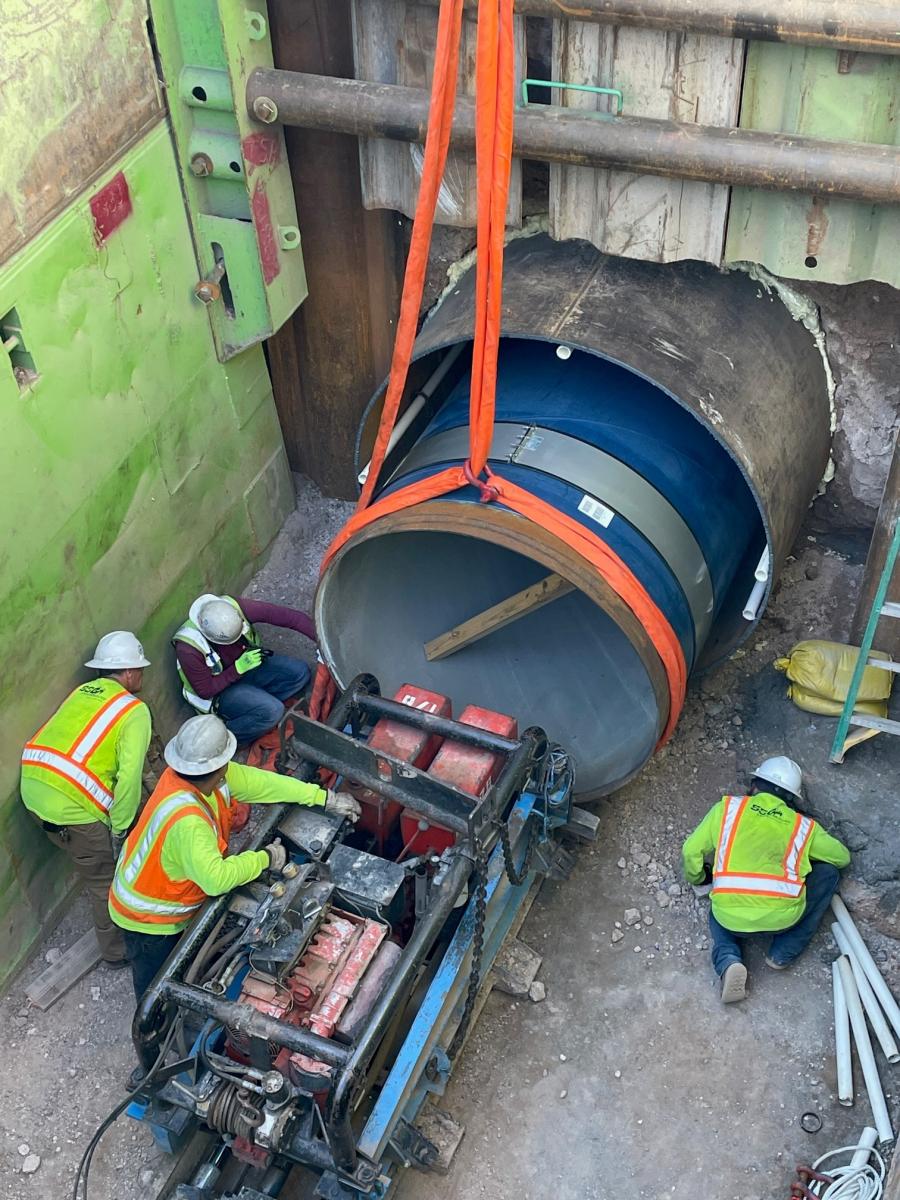SSC Underground provided the tunneling portion of the job, working with lead contractors Sundt Construction, which helped construct six tunnels over a 4-mi. stretch. PCL constructed three tunnels in a water treatment plant while Kiewit assisted with the construction of one tunnel in a single location.
(Photo courtesy of SSC Underground.)
National and local news have been covering the water crisis in America's Southwest and its dependence on the dwindling resources from the Colorado River. Recent infrastructure projects in northwest Phoenix are helping to address that issue in this area of approximately 400,000 people.
The city of Phoenix recently embarked on a project that would provide an underground pipeline to supply a backup water supply from the Salt and Verde Rivers. Phoenix's drought pipeline project included 12 mi. of new pipeline and four booster pumping stations.
SSC Underground provided the tunneling portion of the job, working with lead contractors Sundt Construction, which constructed six tunnels over 4 mi.; PCL, which constructed three tunnels in a water treatment plant; and Kiewit, which constructed one tunnel in a single location.
The tunnelling portion of the job came to $4.3 million.
SSC Underground was tasked with using trenchless technology to burrow through the earth, allowing traffic and everyday life to continue overhead with minimum interruptions. This approach used small skid steers to dig through the rocks and dirt. Workers then used jack-and-bore equipment to push the steel casing into the newly created hole. In the Sundt project, the enormous casings were 10-ft. long and 86 in. in diameter, tall enough that the entire Phoenix Suns professional basketball team could walk through without having to stoop.
Once the tunnel construction began, precision digging was required. On the Sundt section of the job, the workers needed to dig a tunnel so that the casings would connect the pipe being laid by Sundt in open-cut trenches with approximately 1-in. tolerance.
SSC Underground began working on the project in 2019 and wrapped it up at the end of 2022. SSC's consulting division worked closely with design engineers and other contractors to devise an underground road map for the work. Using its underground potholing fleet, the crew located existing utility lines so that they could be relocated or pipeline alignment could be designed around them.
"Every dollar spent on pre-construction potholing/SUE saves $7.82 in construction costs," said Arvid Veidmark, president of SSC. "Often when tunnelling, we will find previously unknown infrastructure, even gas lines, which of course can be quite dangerous."
The tunnel crew installed the steel casings underneath major arterial roadways and intersections, neighborhood streets and an active water treatment plants. Ground conditions ranged from caliche, cemented cobbles, alluvium and hard dirt. Each day seemed to bring its own set of challenges as workers changed strategy to fit the soil requirements. The job required more than 12 trenchless installations. Workers managed each operation to minimize disruption to the public while considering time, cost and risk.
SSC kicked off the tunnelling with a 105-ft. installation of 66-in. casing for a 48-in. waterline under Glendale Avenue at the base of Piestewa Peak Mountain, using a motorized boring unit from Robbins to perform this crossing as the ground was solid rock. Working for Kiewit, this crossing was a key connection as this section ran through neighborhoods and had a major impact to residents.
The second segment included six 86-in. diameter tunnels under intersections along the 32nd Street alignment for a total of 834 ft. for a 66-in. waterline. These tunnels were constructed using an S70 Bobcat skid steer equipped with either a hammer attachment or a rotary head to do the digging in hard dirt conditions. Production varied between 3 ft. to 9 ft. of installation per shift. As a subcontractor to Sundt Construction, SSC worked as a partner to sequence the tunnels to minimize traffic lane closures and keep access as open as possible to the many businesses along this corridor.
"Our deepest dig was 33 feet underground," said Veidmark. "That was inside the water treatment plant. Our work teams had to keep the equipment running yet remain vigilant while tunneling under roads and important structures. We stayed away from a reservoir and a traffic intersection. Often, they found some previously undiscovered underground structure. They had to decide whether to have it removed or tunnel deeper or go around it."
The final segment of SSC's installations was for PCL Construction. The digging team installed three 96-in. tunnels at the origination point of the pipeline, the 24th Street Water Treatment Plant. Using the same skid steer method as in earlier digs, the workers encountered solid rock conditions, averaging 18 in. per shift of tunnel advancement.
These three tunnels — 35 ft., 115 ft. and 101 ft. in length — connect four pits for installation of a 72-in. waterline. Three of the four pits were constructed as semi-permanent structures to allow for the angles and elevations necessary to complete the connections.
Not only did work teams have to deal with hard rock, but also surprising weather emerged.
"Several times our teams came to work and discovered that the pit had been flooded in the night," Veidmark said. "We simply pumped out the water and went to work."
Veidmark is proud of the work that he and his team accomplished for the general contractors in charge of the overall projects.
"Tunnelling allows life on the surface to go on in a normal manner," he said. "It means fewer traffic backups with cars idling for long periods of time. Also, when working underneath a neighborhood we can keep the worksite clean and try to be as invisible as possible."
With other tunneling projects coming for the future, companies like SSC Underground must consider their options.
"Workers are becoming harder to find, so we sometimes look to larger and more efficient equipment to do the job," Viedmark said. "Large tunnel boring machines should be considered as well as improved geotechnical information. We are hoping improved technology will provide answers in our business." CEG
Chuck MacDonald
Chuck MacDonald is an editor, blogger and freelance feature writer whose writing adventures have taken him to 48 states and 10 countries. He has been the editor for magazines on pavement construction, chemicals, insurance and missions. Chuck enjoys bicycling, kayaking and reading. He graduated from the University of Missouri with a degree in journalism. Chuck lives in Annapolis, Md. with his wife Kristen. They have seven grandchildren.
Read more from Chuck MacDonald here.
Today's top stories






















